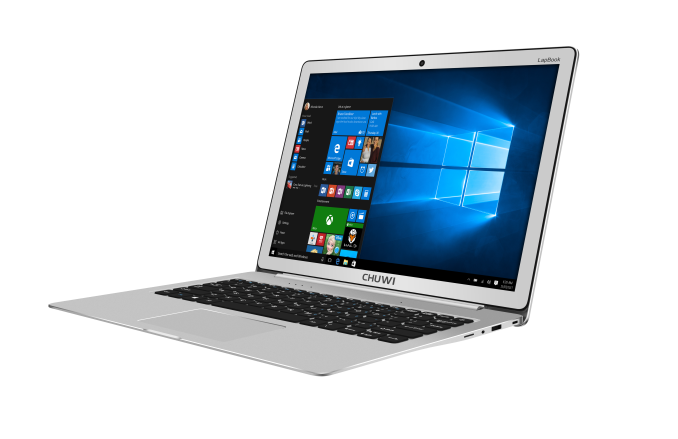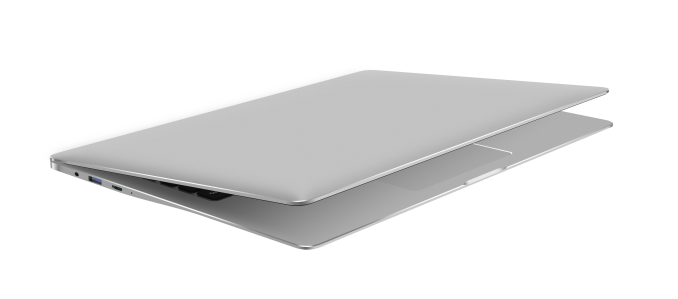Chuwi Announces The LapBook 12.3 With 3:2 267 PPI Display
by Brett Howse on April 8, 2017 2:00 AM EST- Posted in
- Laptops
- Apollo Lake
- Chuwi

Chuwi is a relatively unknown company in the PC space, but only about a month ago we took a look at the Chuwi LapBook 14.1, and came away very impressed. They are shaking up the low-cost segment of the PC market with some low cost, but well featured devices. The LapBook 14.1, for instance, ships with a 1920x1080 IPS display, 4 GB of RAM, and 64 GB of storage, all for less than $300 USD. Normally when you see notebooks around these price points, they come with several serious compromises which really detract from the experience, but the LapBook 14.1 made some great trade-offs to offer a good machine for a low price.
Today Chuwi reached out with some news that they are going to be releasing the LapBook 12.3 at the end of April. It features the same CPU as the LapBook 14.1, with an Intel Celeron N3450, which is a quad-core Apollo Lake. Performance is not as good as a Core based laptop, but the experience is reasonable for less demanding tasks. Chuwi is pairing this with 6 GB of RAM, and 64 GB of eMMC flash storage, so the experience should be similar to the LapBook 14.1, but with more RAM so you can multitask a bit more. They are also keeping the 802.11ac Wi-Fi, which is probably the same 1x1 card found in the larger LapBook.
Probably the most interesting part of the LapBook 12.3 is that it is shipping with a 2736x1824 3:2 display at 12.3-inches. That gives a density of 267 pixels per inch, and eagle-eyed readers might have noticed that this is the same resolution and size as the display in the Surface Pro 4, so it is likely the same panel that Microsoft is using in their tablet. Chuwi didn’t confirm if it was an IPS display, but it most likely is. It's similar to their Hi 13 2-in-1 which uses a 3000x2000 13.5-inch display, so they are clearly using Microsoft's influence to source components which is great to see.
| Chuwi LapBook 12.3 | |
| CPU | Intel Celeron N3450 4C/4T 1.1-2.2 GHz 2MB L2 Cache 6W TDP |
| GPU | Intel HD Graphics 500 12 Execution Units (Gen 9) 200-700 MHz |
| Memory | 6 GB Dual-Channel |
| Display | 12.3" 2736x1824 3:2 Aspect Ratio |
| Storage | 64 GB eMMC |
| Dimensions | 300 x 223 x 16.7 mm 11.8 x 8.78 x 0.66 inches |
| Weight | 1.45 kg / 3.18 lbs |
| Wireless | 802.11ac |
| Launch | April 30, 2017 |
| Price | TBD |
The new LapBook 12.3 measures in at 300 x 223 x 16.7 mm (11.8 x 8.78 x 0.66 inches), and weighs in at 1.45 kg (3.18 lbs), so despite the small and thin design, it’s not as light as a more expensive Ultrabook would be at this size.
Chuwi hasn’t announced pricing yet, but considering the rest of their lineup, it should be very competitive.
Look for the LapBook 12.3 when it launches at the end of April.
Source: Chuwi












35 Comments
View All Comments
flashpowered - Saturday, April 8, 2017 - link
It would be nice if these 3:2 displays were adopted much more widely by PC makers. As much as I love my Surface Book, I want something more like the new MacBook to take everywhere with me and 16:9 is far less comfortable to use when reading and writing on a smaller display.yhselp - Saturday, April 8, 2017 - link
I wonder what type of coating is used on these Surface displays found in Chuwi's Hi10 Plus, Hi12, Hi13, and LapBook 12.3 - hopefully not the matte finish from the LapBook 14.1.haukionkannel - Saturday, April 8, 2017 - link
It is good to see good displays in these cheapo computers. I am so tired of really bad 768 screens in these normally. For writing and reading text these are superior to normal usage, even if the cpu is not too good. If you want to have faster, just spent 2000$, but anyone who does not use this for gaming, this is very good candidate!Give us more machines like this and maybe some bigger brands also find out that people also care about their eyes and overall quality also in this price segment.
yannigr2 - Saturday, April 8, 2017 - link
It took many years for the known tech sites to acknowledge the existence of Chinese smartphones, it's nice to see that they acknowledge the existence of these Chinese laptops. If those laptops get more attention from tech sites and consumers, we might start seeing a few better low end laptops from known manufacturers too.This is a general comment. Just to be clear, I am not pointing any finger at Anandtech. The opposite.
DanNeely - Sunday, April 9, 2017 - link
I'd agree with one major caveat. Only if they address OS licensing problems. As discussed in the comments the smaller Chuwi laptop that was reviewed here recently comes in two price points. For $250 you can have a version running 100% Genuine Warezdoze 10. Or for $265 you can have a model running Win 10, but sold under a program that offers heavily discounted ($15-30 vs nominally $100) licenses for very low end systems, which by virtue of having 64GB of flash instead of the program maximum of 32 the laptop doesn't qualify for.abufrejoval - Saturday, April 8, 2017 - link
I ported the 8Bit color passive frame buffer X-Windows server to an accelerated 32Bit color-depth graphics card in the early 1990's for my computer science masters degree so I've always had this notion that desktops and compute power should not be in the same room, if only for the noise.And I've worked with Citrix since NT 3.51 because that's where I thought Windows started to get interesting.
I like big fat powerful computers, I just never liked the noise they make (it's incredible how low-noise today's desktops have become).
So I bought a BayTrail J1900 motherboard when they came out simply because they were as noisy as a SparcStation 1 to see if they would provide acceptable desktop power while operating without any moving parts. I put 8GB of RAM in it, the official maximum and an Intel Postville SSD, officially retired from my SATA3 desktops, but still a great match for this BayTrail.
It wasn't too bad at 1080p resolutions, even if it lost out in all aspects, graphics and CPU to a Qualcomm 820 mobile part. Office work, browsing, e-mail all of that doesn't require CPU power and if I want more, there is always a couple of fat Xeons just an RDP or x2go session away. Even Steam games stream well enough for some casual gaming to wherever this box happens to sit.
At least it got the software compatibility right, everything from the various Windows versions, different Linux variants, Android-x86 or RemixOS just works fine and out of the box. I remember struggling with VMware ESx, but VMware workstation works just fine, as would KVM, Virtualbox or any container based virtualization solution.
Nice to have something so compatible yet at an energy footprint where you simply don't worry about leaving it on.
I got a Braswell next because I wanted to see how the much beefier graphics would stack up: Well they still lost to the Qualcomm 820, but not as badly. Stuffed 16GB of RAM into that, which works fine (also with the J1900 btw.) never tried 32GB.
That one didn't like Windows 7 as much, although after a BIOS update I guess it would now. I'm switching it between Windows 10 and RemixOS because I see that as the only viable Linux competition on the desktop. And RemixOS is a real pleasure on these devices, because they have very much the same compute and graphics capacity of a high-end smartphone while they use 3-4 times the power (guess that's why Intel gave up in the phone market). Even Android games run really well, as long as they don’t depend on touch screen or gyros.
The relatively brawny iGPU gives a certain degree of snappiness to Braswells and probably Goldmonts (could resist to by that) so unless you are forced to use them (e.g. because your boss wants to stint on the money for your new PC), they are really quite ok. In other words: They are easy enough to like them if you want, but you’ll find plenty of help if you want to hate them.
I've recently done some tests with Windows 2016 and the RDP Client on my Nexus 10 tablet with a bluetooth keyboard just to see how well a potent server + RDP on a light touch enabled desktop might feel. It was much better than I feared so I'm actually thinking about getting either one of these or one of the Lenovo Braswell tablets with Transformer like keyboards.
I also have a notebook with an i5-6267U in it. That's basically the i7-6500U with a double sized iGPU, 64MB of 4th level cache on the CPU die carrier, slightly higher clocks and *cheaper* than the i7-6500: Probably costs Intel twice as much to make as the i7*U, yet they (used to) sell it at a cheaper price just to kick some AMD Kaveri ass. That dual-core hyperthreading CPU will run rings around any true quad-core Atom and puts my 100Watt A10-7850K Kaveri APU to shame at 28Watts.
Of course that chips is the much, much better *everything*, CPU, GPU, SoC. But unfortunately Intel is charging an ARM or three Atoms for it.
It also runs virtually silent in that notebook of mine, unless I start really compute intensive stuff.
I'm perfectly convinced that a nice big passive desktop sized cooler would allow a completely silent desktop with enough power to satisfy any non-gaming workload. It is definitely the better chip for this form factor, it might even sip less power at low load or idle.
But these Atoms are good enough for quite a lot. So I’d buy them and recommend my friends buying them, if only to signal the need for something that sips power and budget like a smart-phone Atom but performs like a mobile i7 with the graphics power well above a Kaveri A10-7850k.
I don’t are who satisfies that need, but I want it quenched: Get to it!
watersb - Sunday, May 7, 2017 - link
A beautiful front-end to server-closet power: we are just now trying to re-visit that with things like nVidia Tegra, right? I would expect a 3K display to require some non-trivial power.I have a big storage bin in my garage filled with cables: VGA, DVI, SCSI, FireWire, eSATA, RS-232, Centronix.. . none of them matter anymore. But it has taken decades to render them obsolete.
I use my iPad for web stuff like this comment, and it seems that the state of our art requires perhaps more computing power than we need to render all the web things.
As a specific solution in a controlled environment, display-server front ends make a lot of sense. As a general consumer product, will we ever be able to deploy simplicity?
Lolimaster - Sunday, April 9, 2017 - link
3:2 is the way to go for computing.TV's in the future and video recording should change to 16:10.
watzupken - Sunday, April 9, 2017 - link
I think the use of a high resolution LCD panel is not required in this case, even though it is good to have. I believe the Apollo lake processor in there will struggle with such a high resolution screen.Nonetheless, it is good to see Chinese laptop manufacturers pushing the value boundary. At the low end market, most of the international manufacturers are just churning out very low end hardware, i.e. use of low end TN panel.
serendip - Sunday, April 9, 2017 - link
I'm still rocking a Baytrail Windows 8" tablet that's great for ultralight travel. I wish Chuwi made a successor to the Surface 3 (non-Pro). A 9" sub-500 g tablet would be perfect.6 GB RAM is huge, I'd settle for 4 GB. 64 GB EMMC is still usable for Windows but a MicroSD card slot is a must. It would be great to have a full size USB or a USB-C slot, so you could charge over micro USB and still use peripherals.